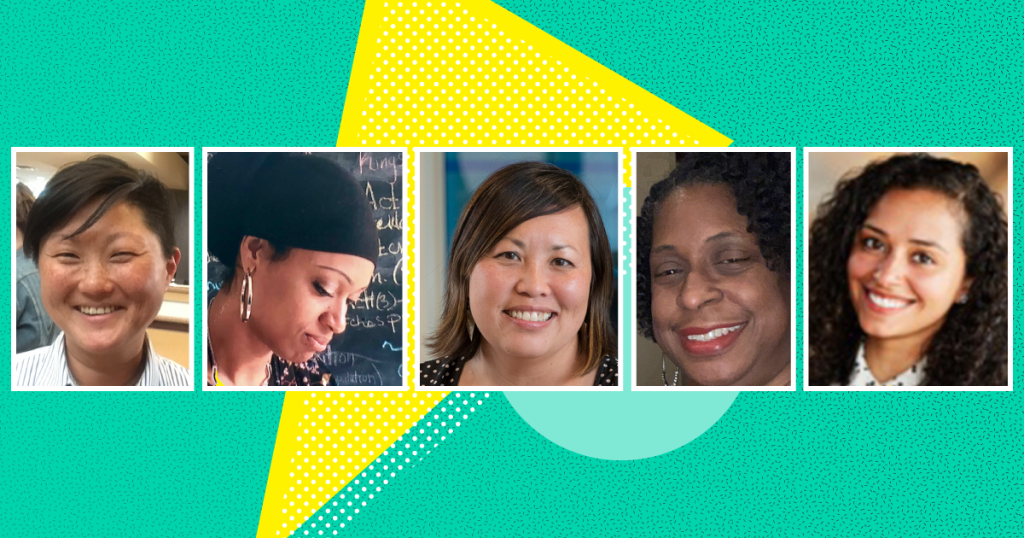This is the eighth post in a year-long blog series on teacher retention. The previous entry looked to local, state, and national data to examine the high turnover rates of teachers of color as compared to that of their white peers. In this entry we seek to amplify some of the stories behind the data—through the voice of current teachers of color.
Research clearly shows the benefit to students of color who have teachers who share their racial and ethnic identity. And for all students, including white students, having teachers of diverse backgrounds can reduce reduce stereotypes and unconscious biases.
Most efforts have focused on how to increase the diversity of teachers entering the profession. But our policies and initiatives have neglected to address the social constructs within schools that frustrate both students and adults who don’t identify as part of the dominant culture, leading many students to disengage and teachers to leave the profession.
I am one of the teachers who left the classroom. As a Mexican American and child of an immigrant I empathized with my ESL students juggling between two cultures that often speak past one another. I was an eager, optimistic teacher who identified with my students and their families. I loved my students and I loved teaching. Like so many, I took on extra periods because “the kids responded so well to me and no one else could control them.” I spent countless hours translating materials for the school. I was the one to communicate bad news to families when the school had waited too long to notice their children.
I lacked the support and autonomy to make broader changes to the schools’ culture to better recognize and support our students. After only a few years, feeling frustrated and powerless, I left the classroom.
Unsurprisingly, we spend a lot of time focusing on those of us who left. I wanted to talk with some of the educators who have stayed—and learn what makes them stay.
Over the last few weeks I have had the honor of speaking with some incredible educators of color who, despite the many challenges and frustrations, have found schools or programs in which they have autonomy and support to create the environments both they and their students need to succeed. Each of these educators work in very different schools and programs, but their experiences demonstrate a few common themes that might guide us:
- Relationships, Respect, and Relating to Students: Each of these educators emphasized the importance of working in programs that value their ability to relate to their students and place a focus on building strong relationships with their students.
- Autonomy to Build Community: The educators highlighted the value of having the autonomy, whether formally or through leadership that shares their purpose, to influence the broader culture of the school or program.
- Respect & Balance: Each educator stressed the importance of feeling respected for what they add to the team.
Relationships, Respect and Relating to Students
When Nafeesah, a former teacher at North High School in Minneapolis, was in her undergraduate years she heard a professor assert that in order to alleviate the traumas that stem from poverty and racism, teachers should be both teachers and psychologists. She then embraced that need and earned degrees in both psychology and education. She believes that being a good teacher requires getting to know your students: understanding youth culture, “who your students are as little human beings”, what their lived experiences were and where they are developmentally as adolescents.
Similarly, when Zaynab, a teacher at Escuela Verde in Milwaukee, talks about her work, she talks about her students. She talks about the relationships she builds with them; about the trust, about how she grew up like them, and how her work is about liberation. “The students are me. I identify with them. I see me in them and I hope they see me in them and that it makes their experience with school less traumatic,” says Zaynab. “Everything I do is by and for my community.”
Krissy, a teacher at Jennings Community School in St. Paul, also stressed that relating to her students means shifting their experience with school. “Growing up as a student of color you are treated negatively, but as a teacher I make sure I treat all my students as kids and learn just as much from them,” says Krissy.
Nou, Senior Director of Community Leadership Programs at the Amherst H. Wilder Foundation in St. Paul, has been leading youth work outside of schools for 20 years now. She does not work in a school but is a powerful educator. Her students in Wilder’s Youth Leadership Initiative (YLI) often report that they are engaged and learn more with this youth leadership program than they do in their schools. Much of YLI’s work is built on deconstructing the norm of traditional school and instruction. Nou explains that at the core of YLI’s work is building relationships, activating interest in learning through hands-on activities, and making curriculum relevant to young people. She believes “schools should be a place where students come alive” and that we must make “time to check-in, to invite people to the space to say I see you and I hear you.”
Shanna, an educator at Franklin Middle School in Minneapolis, prides herself on knowing every student’s name in her school. “You have to learn their story, relate to the kids, and build relationships.” Later when I asked Shanna why she has stayed now for over 20 years, she said, “I stay because it’s my community.”
Autonomy to Build Community
Krissy has worked as both a special education teacher and school director for the past 11 years. For seven years she worked at Academic Arts Highs High School in West St. Paul where she helped the team transition to a teacher-powered governance model. With this model, teachers are able to collectively design and run the school.
Krissy believes that creating a school where adults want to stay is not different from what we should do to help our students feel valued and invested in their schooling. She explained that, “when we create a safe space where both students and adults feel valued and heard people feel respected.” Having the autonomy to create that space has been integral to her success as an educator.
Nafeesah joined North five years ago because she believed in the school’s leadership and is committed to serving the North Minneapolis community. Both are elements she views as essential to her success. Still she sees a lot of room for improvement. “We need to elevate teachers of color voices so it’s no longer an isolating experience of invisibility or suffering in silence. Make teachers of color visible,” she says.
Through her work, Nafeesah has spent a lot of time working with the adults in her building and seeing their critical role as a team. “If you can transform teachers, you can transform the school and the kids,” says Nafeesah.
Nou stresses the parallel between building relationships with students and building an education community that is willing to break down the boundaries that inhibit us. She explains that “educators have to empower ourselves to meet the needs of young people.” This means shifting the culture of schools. In YLI she and her team have worked hard to shift the power to their students. They serve as guides facilitating learning. She stresses that they never ask students to do something they as adults don’t do. It both demonstrates that they are working together and eliminates the traditional hierarchy of our schools.
Shanna has worked in Minneapolis schools for over 20 years. Over this time she has served as a paraprofessional, a family liaison, and has led many projects typically reserved for more senior staff. Most of her career has been spent working in collaboration with the same administrator whom she largely credits with her longevity in the district. She has been at Franklin since it reopened four years ago.
When asked what helps retain teachers of color, Shanna quickly points to the role of leadership in building a shared vision with teachers. She says, “You have to feel empowered to speak your voice and be heard.”
Zaynab has worked as an advisor at Escuela Verde for the past five years. The governance style and values of EV drew her to work there. “I chose to work at Escuela Verde because I was looking for co-conspirators, not allies.” Since Escuela Verde is a teacher-powered school, teachers collaboratively make decisions and each vote counts. “I feel like I can be authentically who I am,” says Zaynab. Her small team strives to be as diverse as possible and, while not perfect, Zaynab expressed that she feels like she can influence changes when needed.
Respect & Balance
Too often, teachers of color are asked to take on extra tasks. At first this may seem like a compliment but the ‘invisible tax’ soon becomes a vicious cycle. The educators spoke about finding that balance and knowing their own limitations. Krissy cautioned that, “Being a teacher of color doesn’t give you a super power, you still have to be human.”
Zaynab shared a few instances where she felt undervalued by her colleagues. After a bit of introspection she was able to talk to her colleagues about what happened. Fortunately, since her team has done the work to build a collaborative community where her voice is respected, she was heard and they were able to find resolution together.
While Nafeesah taught English at North High School in Minneapolis for the last five years, she also led their STEM Academy, served as Equity Lead, and Onboarding lead—and led many other projects as they came up. As a teacher of color Nafeesah is often tasked with leading equity conversations and working with her white colleagues to build their own awareness. This is work she enjoys, but she also finds herself frustrated by how much emphasis districts place on equity work while failing to focus on attracting and retaining teachers of color.
Nou recognizes that she and her colleagues have a lot of flexibility and can be innovative in their nontraditional space. However, shifting our mental models about working with youth can happen anywhere. She sees the mindshift take place often as she works with new staff and volunteers to “unlearn what they think is good youth learning” and also provide them with space to have their change process.
For Krissy, part of the balance has been; “I’ve become invested outside the walls of my school in the education community. It has helped me see the bigger picture.”
Moving Forward in the Profession
This fall Nafeesah has made the difficult decision to leave her students and move to a new program within Patrick Henry, another Minneapolis high school, where she looks forward to having even more autonomy to create an environment in which she and her new students will thrive.
This year, after 20 years in the District, Shanna is taking advantage of a CUE Program available to MPS employees like herself, to participate in a licensure program, free of cost, while continuing her employment at Franklin. She hopes to have her own classroom this fall teaching middle school science.
If we hope to better retain teachers of color, we need to support school communities that value the skills which teachers of color bring to their programs. Teachers must have the opportunity to work in schools that respect their ability to relate to their students and emphasize building strong relationships with their students. Schools and districts must extend support and autonomy to teachers of color so that they can influence the broader culture of the school. And finally, teachers of color need to be respected for the unique skills they bring.
Krissy Wright is a teacher-advisor at Jennings Community School in Saint Paul; Nafeesah Muhammad is an English teacher for The Community Connected Academy at Patrick Henry High School in Minneapolis; Nou Yang is Senior Director, Community Leadership Programs at Wilder’s Youth Leadership Initiative (YLI) in Saint Paul; Shanna Williams is a hopeful Tier 1 science teacher at Franklin Middle School in Minneapolis; and Zaynab Baalbaki is a teacher-advisor at Escuela Verde in Milwaukee.
Found this useful? Sign up to receive Education Evolving blog posts by email.
We are grateful to the McKnight Foundation for their generous financial support for this series.


